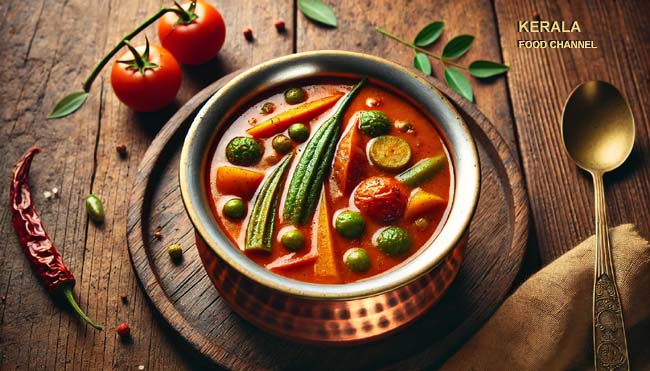Sambar Recipe: How to make easy Sambar?
Sambar is a flavorful and nutritious South Indian stew made primarily from lentils, vegetables, and aromatic spices. Known for its tangy flavor and hearty texture, this dish is a staple in many households. What makes sambar special is its combination of unique ingredients, which creates a deliciously complex flavor profile that balances the heat from spices with the freshness of vegetables. Perfect with rice or dosa, sambar is a true comfort food that embodies the warmth and vibrancy of Indian cuisine. In this recipe, we’ll walk you through how to make a quick and easy sambar in under 30 minutes, making it accessible for both novice and seasoned cooks alike.
Ingredients
To prepare sambar, you will need the following ingredients. These measurements will serve approximately 4 people.
For the Sambar
- Tuvar dal (pigeon peas): 1 cup
- Water: 3 cups (for cooking lentils) + 1 cup (for sambar consistency)
- Mixed vegetables (carrots, potatoes, drumsticks, eggplant, zucchini): 2 cups, diced (about 1/2 cup of each vegetable)
- Tamarind paste: 1 tablespoon (or 1 small ball of tamarind soaked in water and pulp extracted)
- Sambar powder: 2 tablespoons (store-bought or homemade)
- Turmeric powder: 1/2 teaspoon
- Salt: to taste
- Coriander leaves: for garnish (2 tablespoons, chopped)
For the Tempering
- Oil: 2 tablespoons (coconut oil or vegetable oil)
- Mustard seeds: 1 teaspoon
- Cumin seeds: 1/2 teaspoon
- Dried red chilies: 2 (or to taste)
- Curry leaves: 8–10 fresh leaves (optional)
Instructions
Step 1: Prepare the Tuvar Dal
- Rinse the Lentils: Place the tuvar dal in a fine-mesh strainer and rinse under cold water until the water runs clear. This removes excess starch and helps the lentils cook more evenly.
- Cook the Lentils: In a saucepan, add the rinsed lentils and 3 cups of water. Bring to a boil, then reduce the heat to medium-low and cover. Simmer for about 15 minutes or until the lentils are soft and can be mashed easily. If you have a pressure cooker, cook the lentils for about 3-4 whistles with adequate water.
Step 2: Prepare the Vegetables
- Chop the Vegetables: While the lentils are cooking, wash and chop your mixed vegetables into uniform pieces to ensure even cooking. Aim for small cubes, about 1-inch in size.
- Cook the Vegetables: In a separate pot, add the mixed vegetables with 1 cup of water and a pinch of salt. Cook on medium heat until the vegetables are tender but not mushy—approximately 8-10 minutes. You can also cook them in the same pot as the lentils during the last 5-10 minutes of the lentil cooking time.
Step 3: Combine the Sambar
- Mix Lentils and Vegetables: Once the lentils and vegetables are cooked, mix them together in one pot.
- Add Tamarind and Spices: Stir in the tamarind paste (or tamarind pulp), sambar powder, turmeric powder, and salt. Adjust the water consistency according to your preference; it can be thicker or thinner depending on personal taste. Allow the mixture to simmer for 5–7 minutes for the flavors to blend.
Step 4: Prepare the Tempering
- Heat Oil: In a small pan, heat the oil over medium heat.
- Add Mustard Seeds: Once hot, add the mustard seeds and let them splutter for a few seconds.
- Add Cumin Seeds and Dried Red Chilies: Next, add the cumin seeds and dried red chilies. Sauté for another 30 seconds until fragrant.
- Add Curry Leaves: If using, add the fresh curry leaves and sauté briefly (this step is optional but adds an aromatic flavor).
Step 5: Final Touch
- Combine Tempering with Sambar: Pour the tempering over the sambar. Mix well and let it simmer on low heat for an additional 2-3 minutes.
- Garnish: Remove from heat and garnish with chopped coriander leaves.
Step 6: Serving Suggestions
Sambar is incredibly versatile and can be served in several delightful ways:
- With Rice: Traditionally, sambar is served hot with steamed rice. It pairs perfectly with plain rice, ghee rice, or even flavored rice such as coconut rice or lemon rice.
- With Dosa or Idli: Another popular way to enjoy sambar is alongside crispy dosa or fluffy idlis, a savory pancake and steamed rice cake, respectively. This combination makes for a wholesome breakfast or brunch.
- As a Soup: You can also enjoy sambar as a comforting soup, served in a bowl with crusty bread or plain chapatis on the side.
- With Appalam or Papadam: For a crunchy texture, serve your sambar with crisp appalam or papadam alongside it.
- Beverages: Pair your meal with traditional beverages like buttermilk or fresh coconut water for a complete dining experience.
Nutritional Information
Sambar is not only delicious but also packed with health benefits:
- Protein-Rich: The primary ingredient, tuvar dal, is an excellent source of protein, making this dish nutritious and filling.
- Vitamins and Minerals: The variety of vegetables contributes essential vitamins (like A, C, and K) and minerals (potassium, magnesium, and iron), promoting overall health.
- High in Fiber: Braised vegetables and lentils are high in dietary fiber, aiding digestion and promoting gut health.
- Low in Calories: Sambar is a low-calorie dish, making it suitable for weight management without compromising flavor.
- Antioxidants: Ingredients like turmeric and certain vegetables are rich in antioxidants, which help in combating oxidative stress in the body.
Tips for Making Perfect Sambar
- Choose Fresh Ingredients: Fresh vegetables and spices enhance the flavor of sambar. Keep your pantry stocked with quality sambar powder.
- Adjust Spice Levels: Feel free to modify the number of dried chilies based on your heat preference. You can use milder varieties like Kashmiri red chilies for color without too much heat.
- Experiment with Variations: Sambar is highly adaptable. You can add or substitute vegetables like bell peppers, squash, or leafy greens based on what you have on hand.
- Make it Ahead: Sambar can be prepared in advance and stored in the refrigerator for 3–4 days. Just reheat before serving.
- Use Ghee for Extra Flavor: For added richness, consider finishing the sambar with a teaspoon of ghee before serving.
Conclusion
Sambar is a vibrant and nutritious dish that showcases the rich culinary heritage of South India. Whether served with rice, dosa, or enjoyed as a soup, this dish is sure to please the palate of everyone at the table. With its blend of flavors, health benefits, and versatility, making sambar at home is a rewarding experience. With the steps outlined above, you’ll be well on your way to preparing a delicious batch of sambar that’s ready in under 30 minutes, making it a perfect weeknight meal. Happy cooking!






